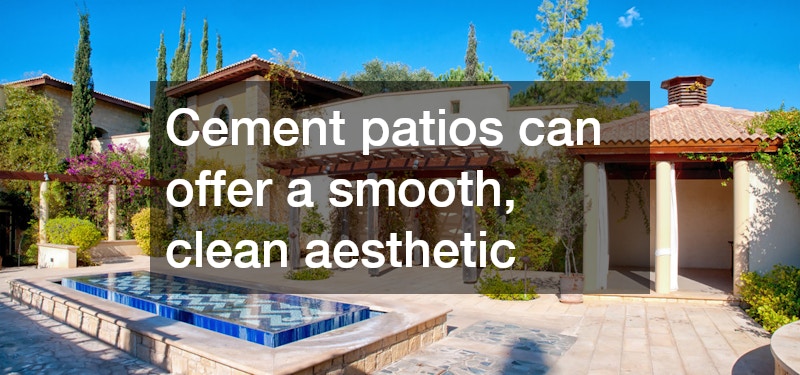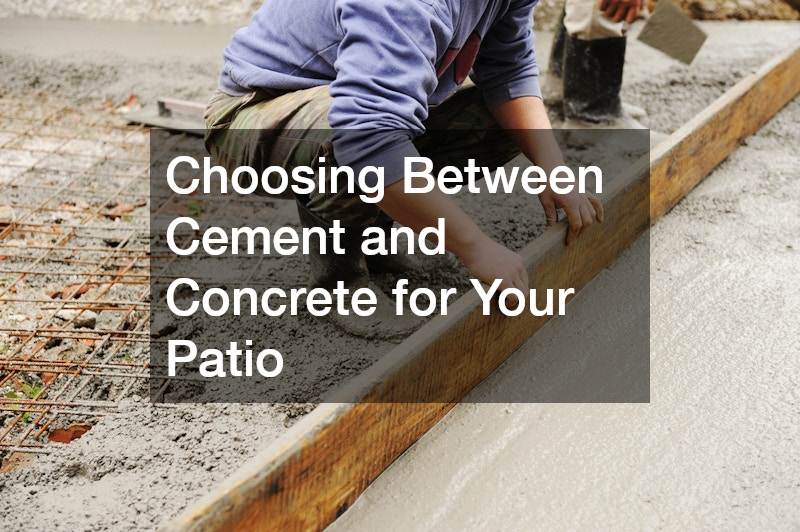Explore the differences and benefits of using cement and concrete for your patio. These answers to common questions can provide valuable insights to help you make an informed decision.
Understanding the Difference Between Cement and Concrete
Cement is essentially a powdery substance made from a mixture of minerals that, when mixed with water, undergoes a chemical reaction known as hydration, leading to hardening. This makes cement a key component in many construction materials, particularly concrete.
On the other hand, concrete is a composite material that consists of cement, water, sand, and aggregates like gravel or crushed stone. While cement acts as the binder, the aggregates provide strength and durability.
It’s crucial to understand that while all concrete contains cement, not all cement is used in concrete. This distinction is important for homeowners considering patio materials, as it affects everything from cost to longevity and installation methods. For instance, local suppliers may cater specifically to location-based needs, offering options depending on what a homeowner might prefer for patio installations.
Furthermore, when discussing differences in application, the context is significant. Cement is typically used in scenarios requiring a fine finish and high binding capacity, while concrete is preferred for load-bearing structures and surfaces such as patios, thanks to its greater compressive strength.
The Benefits of Using Cement for a Patio
Cement patios can offer a smooth, clean aesthetic that can be appealing to homeowners looking for a minimalist look. They generally set quickly, which means the initial installation can proceed without lengthy curing times. Additionally, they can be customized with various colors or textures to align with your landscaping or home décor.
Concrete is also incredibly durable, capable of withstanding heavy foot traffic, outdoor furniture, and varying weather conditions without cracking or fading easily. Its versatility allows homeowners to customize the look with decorative finishes, stains, or stamped patterns that mimic natural stone, brick, or tile. Additionally, concrete patios require minimal maintenance compared to other materials; occasional cleaning and resealing are typically enough to keep them looking great for years. Because of its longevity and design flexibility, concrete remains one of the most cost-effective and stylish options for creating an inviting outdoor living space.
The Installation Considerations
The installation process for cement and concrete patios begins with the site preparation stage, which involves clearing the area, ensuring proper drainage, and laying a solid foundation. Homeowners need to take their time during this phase; a poorly prepared site can lead to a host of issues down the line, from settling to uneven surfaces.
One of the critical elements of installation is curing time. Cement typically sets more quickly than concrete, but this can be misleading. A cement patio may require additional care to ensure it develops the necessary strength and durability. In contrast, concrete requires a longer curing period but ultimately offers a more sturdy and weather-resistant final product.
Enlisting professionals for the installation of concrete patios is often recommended due to the complex nature of pouring and finishing the material properly. Experienced contractors understand how to mix the right ingredients in the correct proportions, ensuring a successful outcome and maximizing the patio’s lifespan.
The Maintenance Required for Your Patio
Maintaining a patio, whether made of cement or concrete, is essential for preserving its appearance and functionality. Regular cleaning is the first step in maintenance; debris such as leaves, dirt, and grime can accumulate, potentially leading to mold or stains if not addressed. Utilizing a pressure washer can effectively remove stubborn build-up without damaging the surface.
Homeowners should also be vigilant about sealing their patios. A high-quality sealant can protect against stains, moisture penetration, and other environmental factors that might lead to deterioration. For concrete patios, re-sealing every few years will enhance durability and keep the surface looking new.
In addition to cleaning and sealing, homeowners should look out for any signs of cracks or chips. Timely repairs can prevent small issues from escalating into significant, costly problems. Regular inspections, especially after severe weather, can help maintain both cement and concrete patios in prime condition.
Choosing between cement and concrete for your patio is a significant decision that can impact the look, durability, and maintenance of your outdoor space. By understanding the differences, pros and cons, performance in weather conditions, installation considerations, and maintenance requirements, you can make an informed choice that suits your needs.
Understanding the differences between concrete and cement is essential when planning your patio project. By recognizing how these materials work together, you can make more informed choices about design, durability, and maintenance. Concrete offers the strength, versatility, and aesthetic options needed to create a patio that not only looks beautiful but also stands up to years of use and changing weather conditions. With the right mix and installation, your concrete patio can provide both function and style for decades to come.




